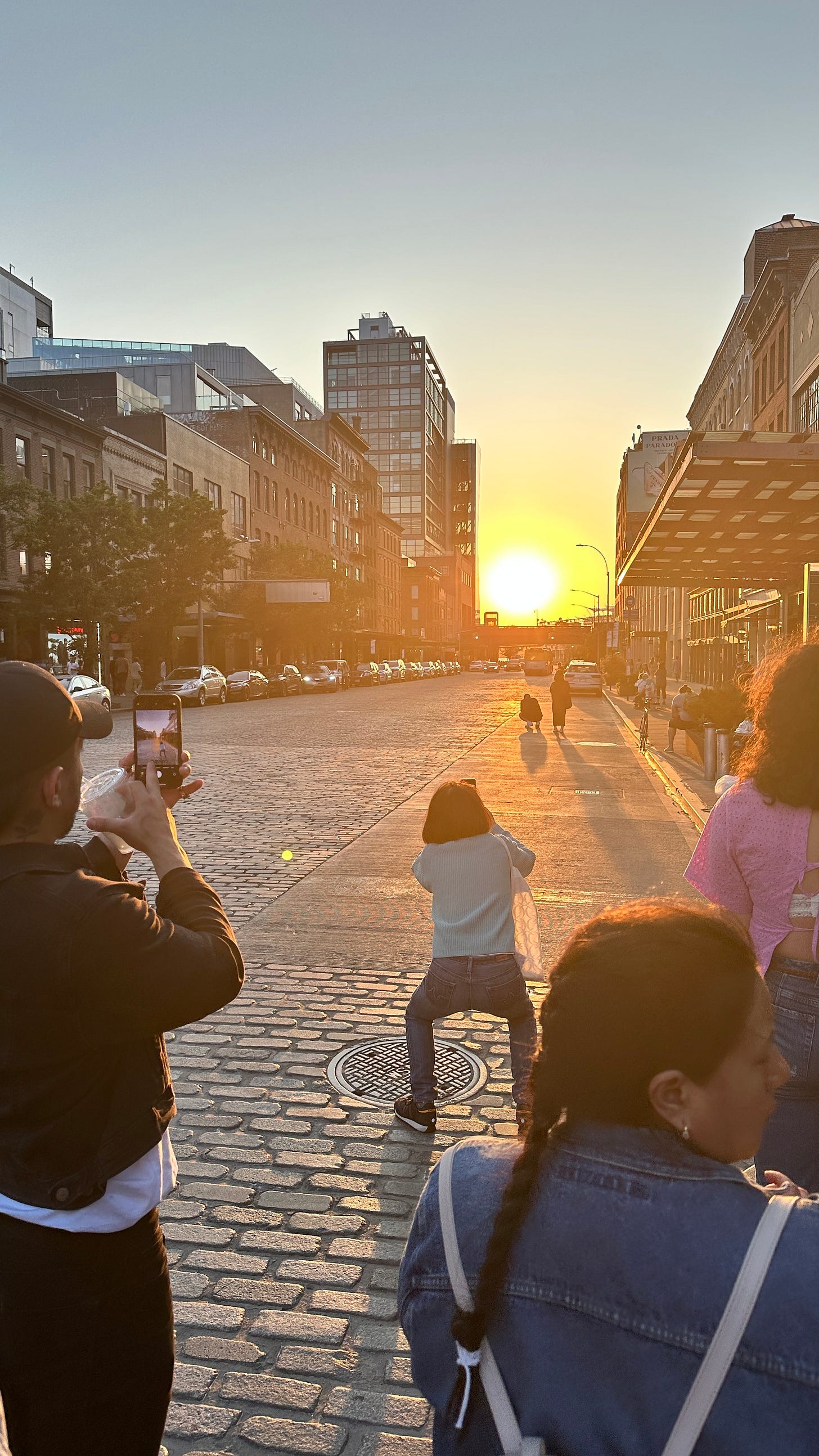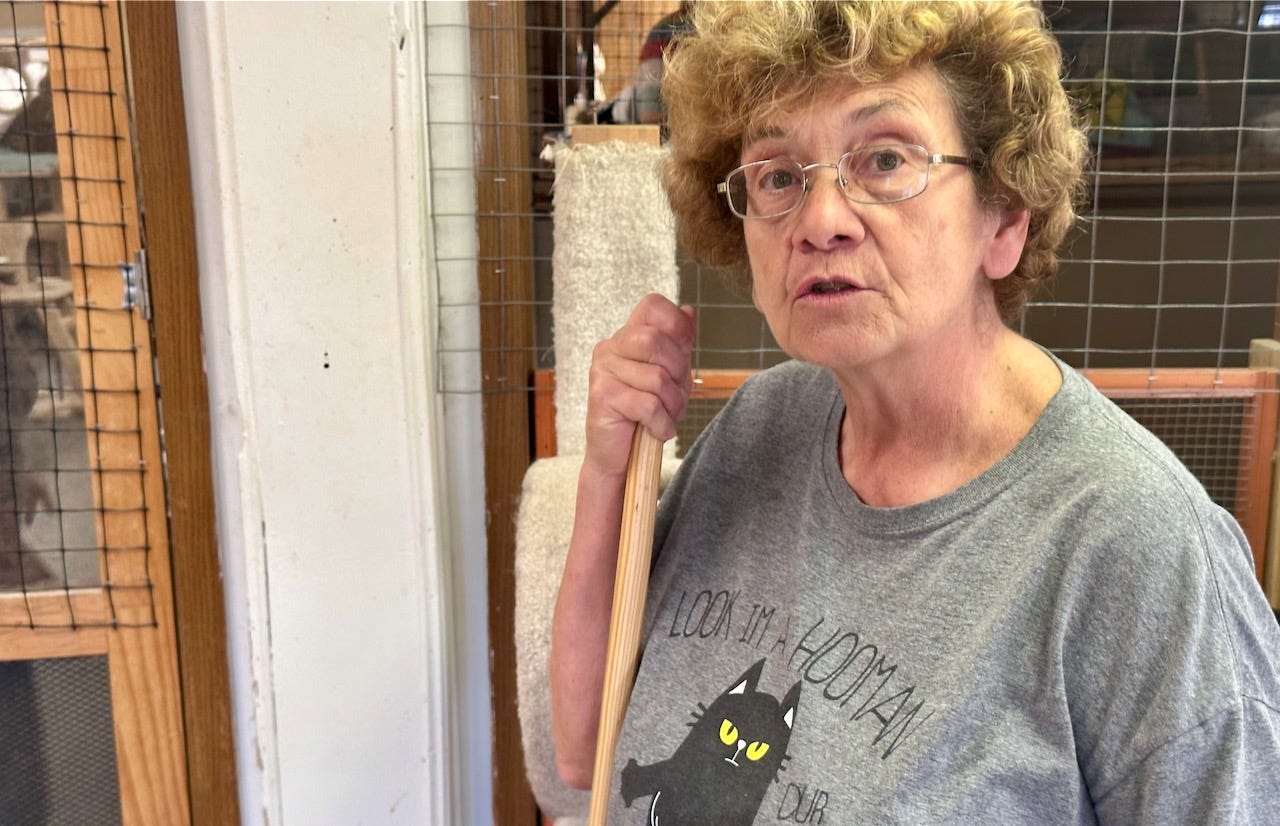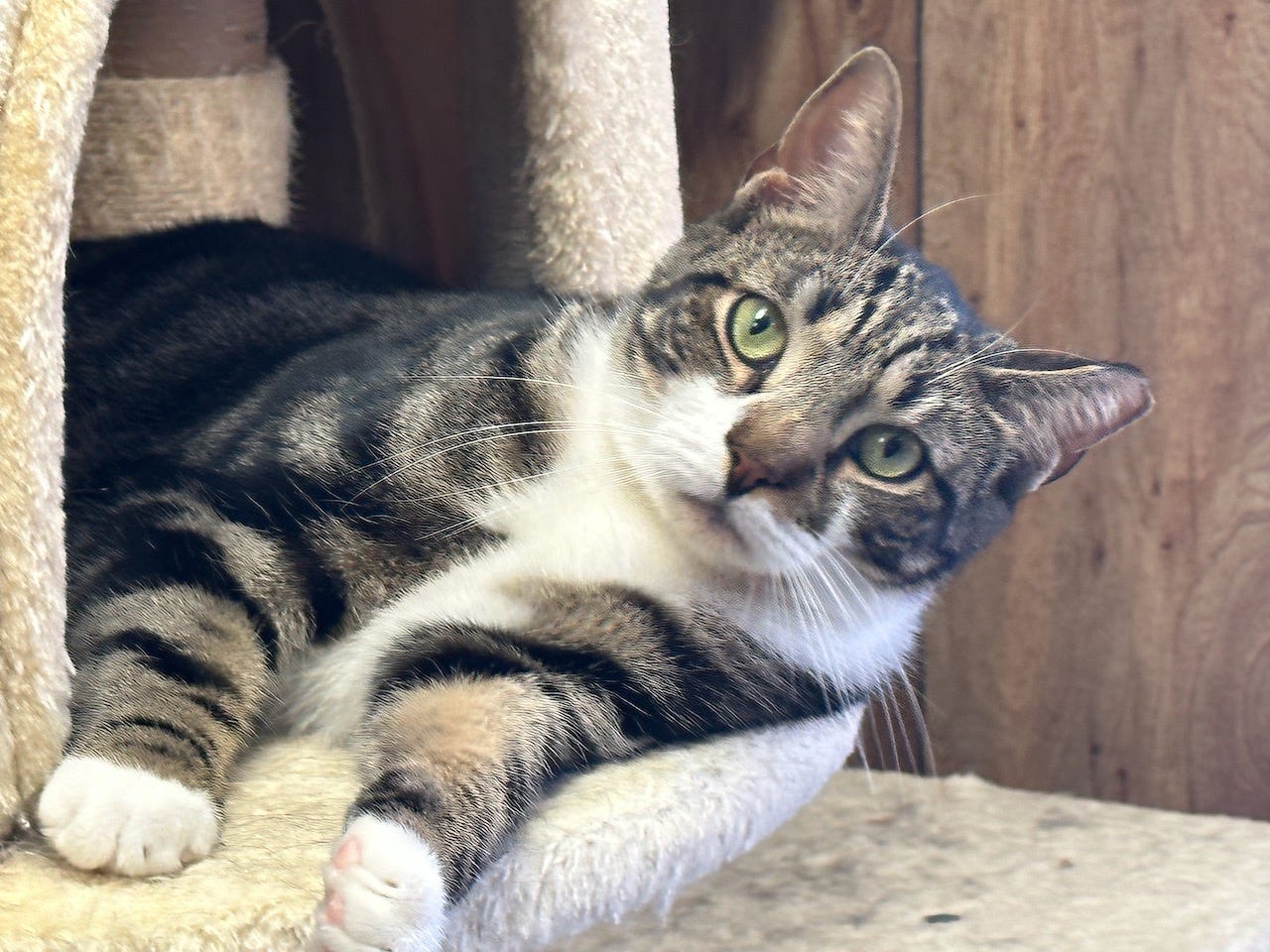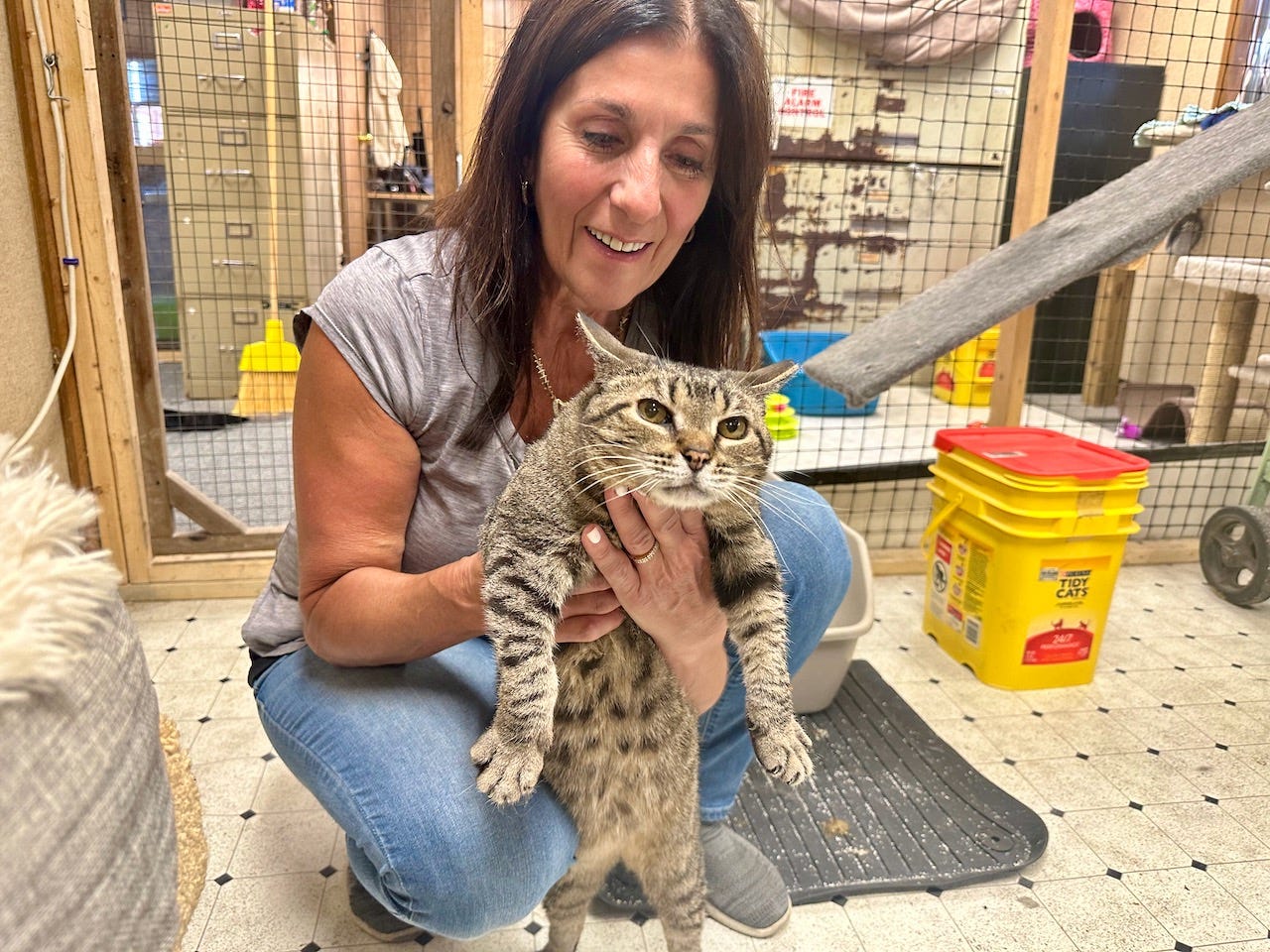Hello everyone,
Welcome to Issue #76 of CAFÉ ANNE!
Back in Issue #72 I wrote about Mike Varley and Jessi Highet who, during their bonkers 7000-mile walking tour of NYC, photographed and catalogued 230 lost pet posters found all over town. The plan was to convert the photos into NFTs, sell them and donate the proceeds to a local pet rescue outfit.
I thought this scheme sounded a little nutty, but Mr. Varley recently emailed with great news. Last week, the NFTs went on sale—and sold out in an hour! The sale raised $4,000 for Rikers Island Cat Rescue, a nonprofit devoted to the feral cats prowling the notorious prison complex.
You can still buy the NFTS on the secondary market, Mr. Varley added. All royalties will support the rescue.
Did someone say feral cat colony on Rikers Island? I know! I had to learn more, so I spent a recent Sunday morning on Rikers, where I met a lot of cats, not to mention a very cool cat lady (yes, there is such a thing). I hope you enjoy the resulting story, even though it is sadly about cats and not dogs.
We also have a new “Ask CAFÉ ANNE” featuring an interview with New Yorker cartoonist Jason Chatfield about his experience with Manhattanhenge. Please enjoy.
Regards!
Anne
ASK CAFÉ ANNE
What’s the Deal With Manhattanhenge?
Q. Have you ever sought out those days of the year that the sun lines up perfectly with the east-west streets of the street grid of Manhattan? I wrote about Stonehenge last week, and my research led me sideways to Manhattanhenge.
I’d love to read your take on Manhattanhenge. How much of a thing is it? Does everybody line up on the street grid facing west every year at the end of May and in mid-July, just to spectate the spectacle? Is it a thing that all New Yorkers know about? Or does it just pass people by?
—Rebecca Holden, UK
Thanks for your question, Ms. Holden! In hopes of getting your question addressed by a true expert, I posted a query in a recent issue looking for a Manhattanhenge aficianado.
I was pleased to hear from Jason Chatfield. He is a New Yorker cartoonist (with a new book coming out this week), standup comic and author of the delightful New York Cartoons newsletter, which he describes as a diary of his life in NYC.
I asked if he was up for a Manhattanhenge chat, and he agreed to share his thoughts. The interview has been edited and condensed. Please enjoy!
So what exactly is Manhattanhenge?
Manhattanhenge is a time, twice a year, that the sun rises and sets at pretty much the same angle as the grid streets of Manhattan. So if one were to stand on 14th, 23rd, 42nd, 34th or 57th Street and look straight down east to west, the sunset will be framed perfectly by the Manhattan skyscape.
It's a very specific, strange thing. It's the same vibe as watching an eclipse. Because you know that it's a rare, naturally occurring thing, it feels special. And it's something we can all share, regardless of our political or religious affiliations or anything. It's the sun. It's the one thing we all have in common.
What's it like to see it?
I accidentally stumbled upon it one night on the way back from a gig. I'd finished a really bad gig and went to a bar to drink my sorrows away. When it came out, I thought it was like a bomb had gone off—the light was so strong that I couldn't see, it was just so great.
I was looking down 14th Street and I remember asking someone, "What the hell's going on?" There were people crouching with their iPhones and giant DSLR cameras with these massive lenses, trying to take photos of the sun.
That was 2014. The following year I actually prepared for it. I got a good camera, started looking on forums and talking to other people who had lived here their whole lives. It was like 50/50. Some said, "It's a thing. I don't really know anything about it.” And then others were deeply obsessive. They plan to go out for drinks or go on to the roof of their apartment building.
Every year, I'm trying to get a better shot. It changes second-by-second as the sun moves and there's a 14-to-15 minute window. And the light is also doing something different, depending on where you're standing, including right in the middle of the f-ing street, which is insane. I've only done that once. That was ill-advised.
I feel like it’s getting bigger every year.
I think social media has definitely made it more of thing. Instagram especially. It used to be people posting photos to Tumblr and Flickr and Facebook for their friends back home. They were saying, "Hey, look what's happening in New York.”
Now, it's like New Yorkers are trying to outdo each other on Instagram, as to who can get the best shot. So it's more popular in the sense that now it's another thing that people can one up each other on: "Hey, I got a better Manhattanhenge photo!"
Are you planning to check out the next Manhattanhenge in July?
Oh yeah! For me, it's better than the Fourth of July. The people who are out for Manhattanhenge, it's a totally different demographic or interest level than the people out for Fourth of July, who just want to get drunk and watch fireworks on the river.
Manhattanhenge is like a natural fireworks. We have no control over it, which I think is part of the appeal. We can't press a button and the fireworks go off. We have to sit and wait for the sun.
And there's just this one window of time, when it's the exact right angle, when it turns the cobblestones into these long shadows. It dances off everything. The light becomes its own character in a show. And it does things to the same park bench that you've seen a million times, that you've walked past every day, and all of the sudden it's lit up in such a way that it's like a painting. It's amazing.
You spoke about it so beautifully. Thank you!
I should add that the July’s Manhattanhenge will take place the same night the New Yorker softball team is going to play Vanity Fair or Paris Review, one of those two. I'm hoping we don't go into extra innings!
Have a NYC question? Please send your query to annekadet@yahoo.com.
FEATURE
The Cat Queen of Rikers Island
When I learned of a volunteer group dedicated to tending a feral cat colony on Rikers Island, I had to learn more. And not because I'm crazy about cats. Quite the opposite! No, I was interested in meeting whomever was behind it. I figured anyone who devotes their free time to herding wild cats on a notorious prison island is likely an interesting character.
I was not disappointed. Gloria Murli, who founded Rikers Island Cat Rescue, was one of the first NYC female prison guards when she joined the force in 1979. She was also the first lady to join the Emergency Services Unit, a team of sharpshooters dedicated to quelling prison riots, thwarting inmate escapes and other high-risk situations.
Her cat rescue work started in 2001, when a fellow guard at Rikers asked her to help him feed a few stray cats.
"It mushroomed into a catastrophe for me," she said. "Twelve years retired, and I'm still here. Now I'm like a prisoner forever! I can never get off this island!"
Rikers Island sits in the East River between Queens and the Bronx; the only way to get there is over a narrow, mile-long bridge. I took the Q100 bus there on a recent Sunday morning, and Ms. Murli picked me up at the visitor's center in her SUV. We started with a tour of the 413-acre island, which is home to ten jails and can house more than 22,000 inmates.
We first stopped at one of the 27 feeding stations that Rikers Island Cat Rescue maintains on the island. There are roughly 300 feral kitties roaming the grounds, Ms. Murli estimates, and they gobble about 13,000 pounds of kibble a year, donated by the Federal Office of Emergency Management. It's typically food shipped up from the south—whatever's left over from hurricane season.
The rescue group's main objective is to reduce the kitty population. Since it launched 22 years ago, it has trapped and neutered more than 1000 felines using Havahart traps baited with tuna and sardines.
Neutered cats are ear-tagged when released, and Ms. Murli estimates 75% of the island's felines now have tags. But it's impossible to trap them all, and it only takes two unfixed beasties to keep the colony going.
We pulled up to an old metal trailer, donated by the Department of Corrections, which serves as an office and a home for several dozen cats. These indoor cats are either too sick to release, have been deemed friendly enough to adopt, or both.
Ms. Murli was on first name basis with each.
"That's Deuces, that's Soprano, that's Ginger," she said, introducing me to a feline trio in room one. "And this is my friend Mary."
Marylois Serra, it turns out, is a human, not a cat. She is Ms. Murli's Hyde Park neighbor and a regular volunteer.
I asked Ms. Serra what her friends think of her avocation.
"They think I'm crazy," she said. "People don't understand. People like their own pets, but they can't give their time. They expect everyone else to do it. She [Ms. Murli] can't do this herself, that's impossible. These cats would starve. We have to take care of them. They didn't get here by themselves."
So how did the cats get on Rikers? Not by doing crimes. Ms. Murli suspects the originals were smuggled in and abandoned decades ago by prison workers: "Anyone could have done it."
The trailer was surprisingly large and offered separate rooms for sick cats, teen cats and kitties.
Sondra, a black-and-white, will be hard to adopt because she can only eat expensive tinned food. Mama has a flesh wound and is on antibiotics. Terry, who hangs out in the office, has a terrible personality—he lures folks in with his snuggling and purring before taking a swipe with his sharp claws.
Given their daily feedings, medical care and cozy beds, it struck me that these trailer cats are living quite nicely. So I asked what I suppose was a fatuous question—who's better off, the island’s cats or the prison inmates?
Ms. Murli did not blink. "Prisoners have rights," she said. "They have to get certain footage, they have to get medical treatment. They get eyeglasses, they get the library, the barbershop, outside rec. They are in jail. They have no freedom, but jail is jail."
Ms. Murli, who is 71 and has a major New York accent, is the daughter of immigrants from Italy who settled in Park Slope back when it was a tough neighborhood. The family later moved to Corona, Queens. Ms. Murli attended Catholic school and then Manhattan's John Jay College of Criminal Justice, planning to be a cop.
"I guess because it was a people job," she said.
The police department had a hiring freeze so she worked as a secretary and bookkeeper before joining the Department of Corrections.
Back then, female guards could only patrol women's prisons. Ms. Murli volunteered to be among the first to patrol a men's prison. She went on to spend most of her 27-year career in a high-detainee jail for men on trial for crimes like murder, rape and armed robbery.
"It was scary," she said. "I used to tell the recruits, 'If you tell me you're coming in here and you're not scared, something is wrong with you. Because you're in a yard and there's 300 inmates and just three of you.' So it's how you control yourself. How you present yourself and how you respect other people. Respect doesn't always work, but nine out of ten times it does."
When the NYPD resumed hiring, Ms. Murli decided to stay in corrections, in part for the opportunity to become the first woman to join the Emergency Service Unit. "I was very lucky to be there," she said. "They respond to riots or any kind of problems in the jail—I like a challenge."
Ms. Murli was on call 24/7, responding via beeper to any emergency.
"It was a rough time. There was a lot of different things going on, fights, it was a crowded jail—22,000, 23,000 inmates," she said. "There was always something when you have a lot of people incarcerated in the heat. They don't want to be here. You know, things are rough. You have to get it under control as fast as you can."
She was soon promoted to captain, overseeing an Emergency Service Unit squad and more than 100 guards.
Her weapon of choice? "A sense of humor," she said. "If you don't have a sense of humor here, you might as well not be here. In life, if you don't have a sense of humor, you might as well not be there."
She also relied on listening. "Listening is the key to everything," she said. “Listen, don't shoot from the hip. It took a lot of time to learn how to do that. Don't get excited. Listen, listen to what's happening. Be calm."
"Don't second-guess people in front of them," she adds. "Keep it in your head. Don't let it out. Think, think."
Despite her talent for calm, the job changed her, she said. She started off quiet and reserved. "But if you're not aggressive here, you're not going to survive," she said. "You can't be a wallflower and start crying. Doesn't work."
By the time she retired in 2011, she was a super-aggressive, foul-mouthed lady.
"I adjusted too well! I was institutionalized," she said. "Isn't that a terrible thing to say?"
She took a job as a reservations desk agent at nearby LaGuardia airport. "To rehabilitate myself, see if I can deal with the public," said Ms. Murli. "It was a great experience going there. I calmed down, learned how to deal with the general public, and not curse."
She now runs her own small, private security agency handling special jobs, like diplomat protection. Several days a week, she still does security work herself.
The cat thing started mid-career. A dog person at heart, the cat service started with helping a fellow officer feed a few stray cats outside one of the jails.
Soon after, a kitten was injured when an inmate threw it into a razor-wire fence. The media got wind of the island’s feline colony and an uproar ensued. The New York Post dubbed Rikers a "sexual Shangri-La" for cats.
The Department of Corrections commissioner approached Ms. Murli for help. "I don't care what you do," he said. "Just fix it!"
Ms. Murli launched Rikers Island Cat Rescue in 2001. When she retired from the Department of Corrections ten years later, there was no one to take her volunteer role. She still returns three days a week, assisted by a small crew of fellow helpers.
"What do you get out of it?" I asked.
"I get personal satisfaction out of helping these animals that most people are like, 'Oh they'll eat a mouse, don't worry about it,'" she said. "It's satisfying to be able to know that at least it's a little penny in the bucket."
When she drove me off the island, we stopped at a security station where two guards approached her SUV from either side.
"Wait a minute here, I got two handsome men. I don't know which way to go! Where am I going?" said Ms. Murli.
One of the guards asked how I'd enjoyed my visit.
"It was wonderful," I said.
"She didn't take any of the damn cats though," said Ms. Murli.
It was the first time she’d cussed all day.
Rikers Island Cat Rescue operates entirely on donations. The easiest way to help is by ordering food and supplies for the organization from its wishlist on Chewy.com. You can also find Rikers Island kitties available for adoption on Petfinder.
CAFÉ ANNE is a free weekly newsletter created by Brooklyn journalist Anne Kadet. Subscribe to get the latest issue every Monday!






















in a way, aren't we all just feral cats on Rikers Island waiting for our Gloria Murli to save us?
Great reporting on the cat lady of Rikers. I worked in their PR office in the late 1970’s -- around the time she began her career as a correction officer -- when the prison population was a fraction of today’s and the island far less built up. There was so much lawn you could spot pheasant there. Wasn’t aware of the cat population back then. It probably exploded along with the prison population. Wonder if there’s a correlation?